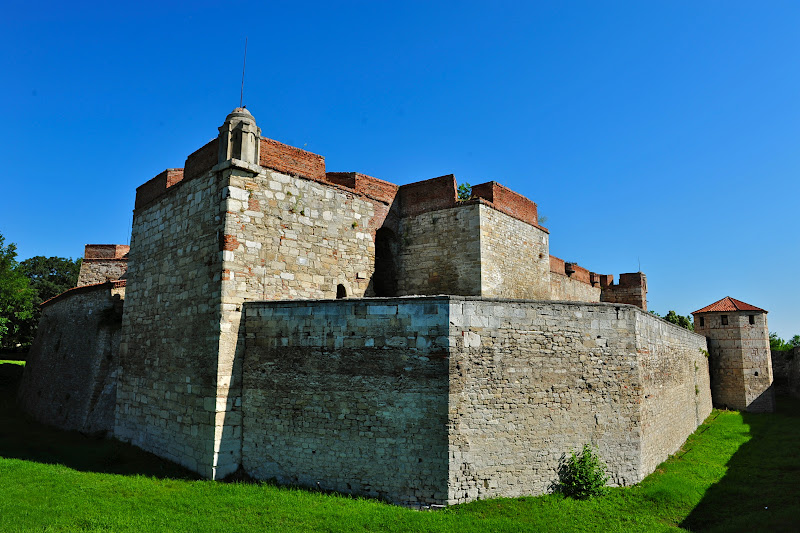Baba Vida castle (Баба Вида крепост), sits in the unexciting town of Vidin, watching over a broad stretch of the Danube. When we arrived, on a still-hot evening as the sun was going down, there was a volleyball game happening on part of the outer wall. A few straggling sunbathers lay out on the grass (including a suspicious, naked man) and an elderly couple toweled off after their swim.
The fortress was serene and jumbled, a confusing cluster of towers, brickwork and walls. It's a mix of styles - Bulgarian, Austrian, Ottoman - and periods, with 19th century touches and old Roman foundations, still visible, underneath. We slept in town and came back in the morning to take a closer look.
There is a legend about Baba Vida which goes something like this: at the end of the 10th century, a great Bulgarian king died. His lands were divided amongst his three daughters, who each received a stronghold and city. Two of the daughters married bad men who squandered their father-in-law's wealth and lands, but the third, Vida, never married. She settled quietly in the town of Bdin (currently Vidin), where she built a castle and remained much beloved by her subjects. After she died, the townspeople began calling the fortress "Baba Vida," or "Granny Vida." Nobody's quite sure if this is true, but it's certainly a strange name.Bulgaria once had many castles, but most are ruined - other than the sham castle in Veliko Tarnovo, this is pretty much the best the country has to offer. It's in great shape, with a grassy moat and pretty towers, a lot of history and a nice compactness.
There are parts of the tenth century structure still intact. However, like most castles that remained in use, there have been many modifications. The biggest additions are mostly lost in the scrubby riverside undergrowth - long cannon embankments that surrounded the older fortress. Bits and pieces of these are still visible, but not much. A lot of the riverside wall was destroyed to build a modern levy, and other parts were flattened to make way for apartment blocks.
Luckily, the main stronghold has remained, though it's in a much different condition than it used to be. The Ottomans, who ruled the region from the 14th to the 19th centuries, made the most changes, along with Austrian allies who occasionally were charged with the castle's defense.
As cannons became more common, castles began being built specifically for them. Older buildings, like Baba Vida, were often retrofitted - but any new structures had a decidedly different look to them than the antiquated, high-walled tower-cluster that had dominated earlier periods. High walls were great for archers, but terrible for big guns (I've covered a lot of this in more detail here and a little bit here). By the 1600's and 1700's, most medieval castles had been abandoned or completely overhauled. By the 1800's, they were almost completely obsolete - there was only so much one could modify an old fortress, most rulers preferred to build something new.
Baba Vida is different - it was used right up until 1865.
Like many fortresses, Baba Vida had to be refitted for cannons at a certain point, which changed how the outer walls were built and necessitated a system of ramps inside to get artillery from place to place. Later, when Vidin wasn't strategically important anymore, the castle was used for munitions storage. At the beginning of the 1800's, some 15 feet of sod and soil were piled over the inner roofs to make the gunpowder rooms safer. Consequently, most of the fortress is now a large, elevated, grassy surface covering bunker-like chambers beneath. Because of this, the towers look quite stubby from inside. There are interesting doorways built to access the lower parts of the towers and some nice wildflowers.Because most medieval castles weren't used into the 19th century, they were never outfitted with defenses that reflected the military shift towards smaller, lighter guns. As old cannons were replaced, for the most part, by more portable firearms (muskets and rifles), the need for thick, heavily-fortified battlements diminished. But because Baba Vida was a guarded munitions store, it got new, brick parapets with narrow, slitted firing positions. Interestingly, these smaller embrasures are very similar to the old arrow loops that were phased out when cannon architecture became more common.
It's interesting to find, in this river delta, a castle made primarily of stone, which is scarce. Typically, small stone castles (as opposed to quarried rock structures) crumble and are in worse shape, but here an amazing amount of detail has survived. After the Ottomans took power, this part of Europe was rarely fought over, and the fortress, in its present form, was never seriously attacked.
Baba Vida is at the outskirts of Vidin, where the town trickles out into a mess of low branches and former floodplain. Around the castle is a tree-filled park that winds its confusing way along the riverside into the heart of town. Much of the park has been neglected and has a post-communist messiness that manages somehow to be endearing. There is a graffiti'd statue of Mother Bulgaria and a popular pizza place, an almost-derelict rowing club, an abandoned church (or maybe synagogue). Walking to our morning photo session, we passed a young prostitute standing in the shade of a sycamore. A few early risers were already lying out on the "beach" by the water. Swimmers and kayakers dotted the smooth surface of the Danube. Behind it all, completely ignored, the castle was a pretty yellow in the slanting light - we had Bulgaria's premiere, best preserved castle all to ourselves.
You have read this article Bulgaria /
Castles /
History
with the title Castle Hunting: Baba Vida. You can bookmark this page URL http://africathoughts.blogspot.com/2012/06/castle-hunting-baba-vida.html. Thanks!


















No comment for "Castle Hunting: Baba Vida"
Post a Comment